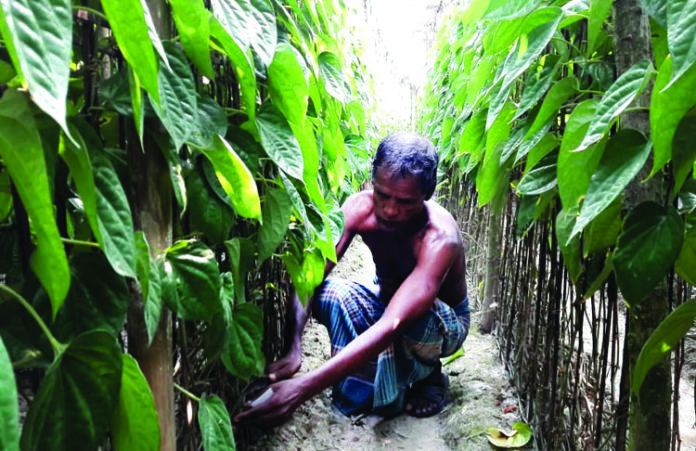RAJSHAHI, Dec 11, 2019 (BSS)- Betel-leaf farming has been playing a vital role towards improving socio-economic condition of people in many areas of the region as it has an extra fame for the crop and its marketing.
As it’s more profitable than many other crops to the farmers number of its farmers and acreage is increasing day-by-day.
Local farmers are becoming interested in betel leaf farming as they have been getting fair price of the produce in the market for the last couple of years.
Now, farmers are passing busy time preparing their gardens for betel leaf farming. This year, they are bringing more land under betel leaf farming.
Farming of the cash crop has become doubled this year only in Mougachhi village under Mohanpur Upazila. More than twenty farmers including Gaziuddin Sheikh, Abdus Salam and Altaf Hossain have set up new ‘Baraj’ a unit of farming this year.
Muhammad Ali, a farmer of Chandapur village under Bagmara Upazila of the district, has become self-reliant through betel leaf farming.
As the first betel leaf grower in his locality, Ali earned fame as a successful farmer in the region. His three sons- Aminul Islam, Abdul Hamid and Ali Hossain extend support to his works earnestly. By dint of his hard work and relentless efforts towards the betel leaf farming, Ali built a concrete house for the first time in the area. Witnessing his success many of his neighbours became inspired and established ‘Baraj’ and they are now doing well.
At present, the three brothers have set up separate ‘baraj’ and they have also become successful farmers.
Mahbub Alam, 48, a farmer of Mougachhi village under Mohanpur Upazila, said betel-leaf cultivation is more profitable than many other crops if it doesn’t infected with disease.
A farmer can earn Taka three to four lakh from a 10-katha baraj in a year which isn’t possible from any other crop.
Tota Sheikh, another farmer, said from each plant, 12 to 15 seedlings can be planted. Bamboo, jute stick and thread are used to prepare the betel leaf garden.
When the plant is four to five inches long, then a five to six foot long jute stick is placed on the side. The leaves become mature for sale after five to seven months. Then in every eight to 10 days, the leaves can be taken to the market, he added.
Shamsul Haque, Deputy Director of the Department of Agriculture Extension, said betel-leaf is cultivated on around 2,021 hectares of land in the district yielding around 34,954 tonnes valued at around Taka 110 crore every year.
Farmers are easily getting more profit from betel leaf farming than other crops.
Living and livelihood condition of more than one lakh people in Paba, Mohanpur, Bagmara, Durgapur, Puthiya and Charghat Upazilas are dependent on the cash crop farming.
Many of the village markets and growth centers including Mougachhi, Mohanganj, Taherpur, Monchmail, Naohata, Dawkandi, Kaloiganj and Kanpara have earned fame and dignity in the region in terms of selling betel-leaf side by side with generating employment scopes for the adjacent people.
If the existing problems particularly the disease infestation being faced by the farmers were removed the crop, undoubtedly, can contribute a lot towards furthermore boosting the economic condition of the region, said Monsur Rahman, Chairman of Paba Upazila Parishad.
Professor Mustafizur Rahman of Department of Agronomy in Rajshahi University said betel leaf farming is profitable compared to many other crops adding that Taka two to three lakh could easily be cashed from one bigha of land if the farming was modernized. He said acreage of betel leaf farming is around 2,000 hectares in the district producing around 35,000 metric tons of crops valued at around Taka 90 crore annually and over 25,000 farmers are involved in its farming directly.



